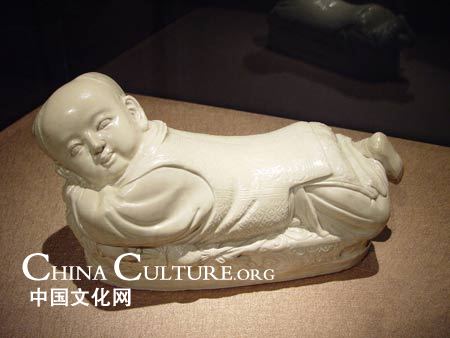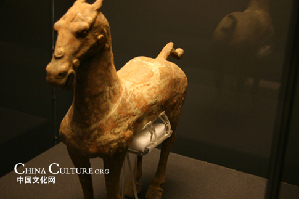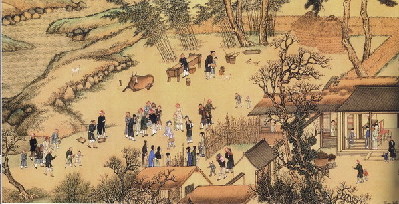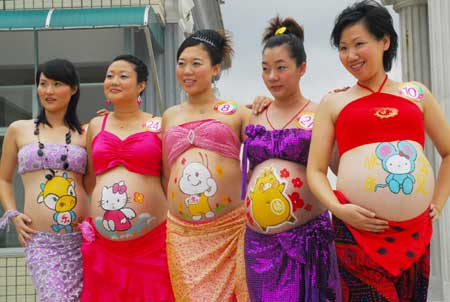| Home > Living in China > Art |
Peking Opera,aesthetically appealing art
 Peking Opera costumes
Peking Opera costumes
Peking Opera costumes, generally referring to what an actor or actress wears on the stage, are technically termed xingtou or, more popularly, Xifu in Chinese. The origins of Peking Opera costumes can be traced back to the mid-14th century, when operatic precursors first began to experiment with large, ornate articles of clothing.
·Characters featuring Peking Opera costumes
A performer's costume primarily designates his or her role on the stage no matter when or where the action takes place. For instance, an imperial robe is suitable to any emperor ranging from the ancients of the Shang Dynasty (16-11th centuryBC) to the royal rulers of the Qing Dynasty (1644-1911).
Regardless of the four seasons of the scenery background, the opera costume is always the same. For example, the young scholar Zhang in Romance of the Western Chamber wears the same silk gown both on his February visit to Pujiu (Save-All) Monastery or when he takes leave of his beloved, Cui Yingying, at a farewell party in the fall.
Peking Opera costumes give voice to a character's sex and status at first glance. In terms of symbolic function, they have done well in marking off people from all walks of life, noble or humble, civil or military. For example, the wear of a beggar's gown patched with satin suggests that the character is temporarily poor but expects a bright future.
By means of costumes, the good and the evil are clearly distinguished. For instance, the wings (chizi ) attached to a gauze hat indicate a loyal official if they are in the form of oblong. In contrast, a corrupt officer is made to wear a gauze hat with rhomboidal wings.
Accessories, including helmets and hats, constitute an integral part to bring about dramatic stage effects. For instance, the wings attached to a hat, the plumes (lingzi) pinned to a helmet, and the cascading sleeves (shuixiu ) sewn to a garment, though short of practical function, are acclaimed as the representative of Peking Opera's beauty.
·Categorization of the theoretical costumes
In the early days, opera costumes were mainly made of wool or coarse cloth; later, satin, crepe, and silk were used, decorated with various meticulously embroidered patterns. The making of opera costumes is a special and unique stagecraft. The costume box first appeared in the Ming Dynasty (1368-1644), and was greatly improved in the Qing Dynasty.
Official Robe (guanyi )
Guanyi is also called yuanling (round collar). It is formal wear for civic officials. It features a jade girdle around the waist and an embroidered mandarin square, one each on the chest and the back. Guanyi in black indicates of the lowest official post while the white Guanyi suggests that a certain royal household member has died.
Ancient Costume (guzhuang yi )
Guzhuang yi is formal wear for royal ladies or fairies. It features elegant colors and simple designs.
Palace Garment (gongzhuang )
Gongzhuang is a kind of informal dress for queens or princesses. It is commonly made for characters of fairies, imperial ladies, and royal concubines. The garment features red colors and is luxuriously embroidered with the design of phoenix and peony.
Colored Gown (Kaichang )
Kaichang is also a long robe with a sloping collar and wide sleeves. Characters without an official title cannot wear a kaichang. However, the rank of one who wears a kaichang is lower than one who wears a mang. Usually martial roles wear a kaichang, while civic officials wear a guanyi (official robe). Embroidered patterns like lions, tigers, leopard s, and kylins are featured in kaichang.
The Rich-to-be Gown (Fugui yi )
Fugui yi is called qiongyi (the beggar's gown) in that the character is poor at first but becomes rich later. Thus, the gown is viewed as a propitious sign.
 |
 |
Gown with a Sloping Collar (Zhezi )
Zhezi is widely used and can be worn by characters regardless of status and gender. It features a large sloping collar and resembles a Taoist's robe.
Armour (Kao )
Kao is special wear for characters of military officials. Kao is classified into "grand" ones and "light" ones. A "grand" kao is equipped with triangular banners on the back. Both grand kao and light kao are dramatized costumes in that they are not found in historic Chinese martial attire.
Gown with a Vertical Collar (Pei )
Pei is a long robe with wide sleeves. It has symmetrical fronts with a vertical collar rather than round or sloping collars. Pei is suitable for characters that are either high officials or belong to the upper-class.
 |
 |
Python Ceremonial Robe (Mang )
Mang is worn by actors playing emperors, ministers, commanders-in-chief, and other high-ranking officials. Embroidered patterns on a mang usually include "circular dragon ," "spread-out dragon," and "large dragon." The emperor wears a yellow mang with five claws. The others wear mangs with four claws.
 Facial Make-up in Peking Opera
Facial Make-up in Peking Opera
 |
 |
 |
 |
Lianpu (facial make-up in Peking Opera) is a unique way to portrait characters, which is native to China. It refers to the color patterns painted on the faces of opera performers. Some people argue that the make-up is similar to the mask. Nevertheless, there are great differences between the two in that masks are separate from the face.
Specific types of facial make-up are exploited in Peking Opera to symbolize the personalities, characteristics, and fates of the roles. Usually, red faces have positive meanings, symbolizing brave, faithful, and wise men. Another positive color is purple, which signifies wisdom and bravery.
Black faces, for their part, usually have neutral meanings, symbolizing just brave men; however, they can also represent uprightness. Blue and green faces also have neutral meanings that symbolize the hero of the bush, with the former also hinting at strength and intrepidity.
Meanwhile, yellow and white faces have negative meanings that symbolize ferocious, treacherous, and crafty men.
Finally, gold and silver faces symbolize mysteriousness, and stand for monsters or gods.
Making facial makeup is a special skill for Peking Opera professionals. When a character's face needs to be exaggerated, a makeup type is painted. The most common facial makeup types are jing and chou. Jing is an actor with a painted face and chou is the role of a clown.
For different roles with different makeup types, ways of color application and painting are different. For some makeup types such as one for a hero, color is applied to the face with hand; no paintbrush is used. For most types of warrior, colors mixed with oil are painted on the face, and meticulous attention is paid to shades of coloring, the size of eye sockets, and the shape of the eyebrows. For treacherous court officials, the face is painted white, with the eyebrows and eye corners slightly accentuated and a couple of "treacherous" lines added.
To the Chinese, Peking Opera is more than the honored quintessence of Chinese culture but has been rooted in the veins of the native people.
In China, Peking Opera lovers are called Xi Mi or Piao You. Xi Mi refers to an opera fan while Piao You is a special operatic term titled to amateur performers of Peking Opera. Among the numerous amateur performers, some have done well and even gone beyond professionals in terms of technical skills.
Art
 more
moreClassic Chinese Handicraft:
Porcelain pillows, as classic Chinese handicraft,

Chinese Treasures Returned from
As witness of Chinese culture and custom, countless treasures

The lost legacy: classical music
Accompany by the long history of China, Chinese classical music

Customs
 more
moreChinese Kungfu
Kungfu Taste: Learn Martial Art in Shaolin Temple
The mention of Shaolin Temple conjures up images of a quiet and
Keet Kune Do will reappears on screen: BRUCE Lee and
The Legend of Bruce Lee is shot by China Central Television
The Road to the Olympic Games for Wushu
Wushu, also called kungfu, martial arts, is attracting more and more




 print
print  email
email  Favorite
Favorite  Transtlate
Transtlate 



